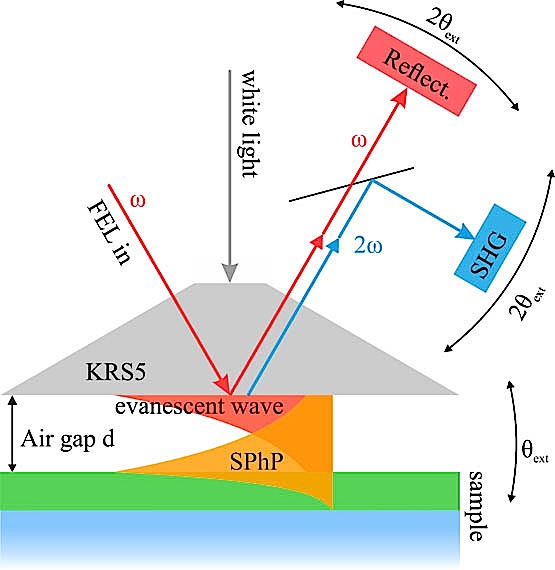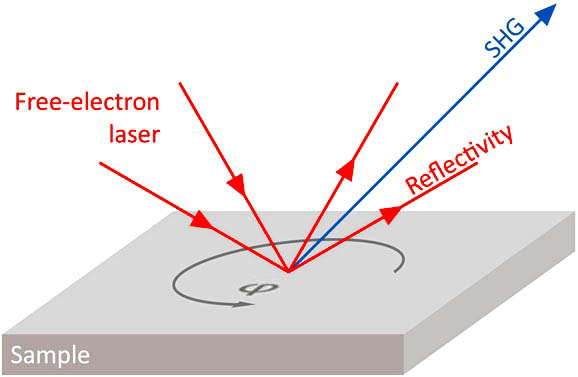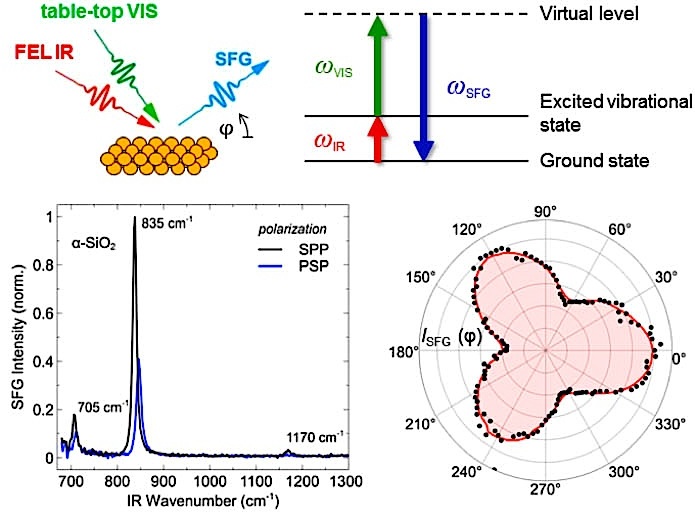Surface Phonon Polaritons in Polar Dielectric Heterostructures
Surface phonon polaritons (SPhP) are recently investigated as an alternative building block for mid-infrared (MIR) nanophotonic applications, promising to possibly solve the intrinsic loss problem of plasmonics. SPhPs arise in polar dielectrics due to IR-active phonon resonances, leading to negative permittivity between transverse and longitudinal optical phonon frequencies, a region called the reststrahlen band. Similar to surface plasmon polaritons (SPP) in metals, the enhanced local optical fields of SPhPs enable a variety of nanoscale applications in the nonlinear optical regime, such as highly efficient sensing or all-optical switching. In ultrathin polar crystal films, even larger optical field enhancements arise for the Berreman mode due to its resonance frequency being in the vicinity of epsilon-near-zero (ENZ).

In contrast to SPPs, the strong dispersion of the SPhPs in the Reststrahlen region provides a natural way for tailoring SPhP resonances. Multilayers composed of different polar dielectrics with overlapping Reststrahlen bands exhibit a variety of novel phenomena such as mode-splitting, index-sensing, and wave-guiding, thus allowing for the engineering of novel hybrid materials with custom-designed polaritonic response.
Further, the excitation of SPhPs is intrinsically limited to p-polarization. On the contrary, waveguide modes in high-permittivity films can couple to both p- and s-polarized light, and in thin films, their confinement can become comparable to SPhPs. Thus, in addition to the polarization-limited SPhPs, polariton-like waveguide modes provide a promising complementary building block for omni-polarized nanophotonic applications, such as in-plane metasurfaces or polariton lenses. Our current research focuses on the study of SPhPs and waveguide modes in heterostructures comprising SiC, AlN, and the phase-change material Ge3Sb2Te6 (GST), employing linear and nonlinear MIR spectroscopy in free-space excitation and Otto-type prism coupling. All experimental observations are corroborated by a specifically developed matrix formalism for anisotropic multilayer wave propagation, in order to achieve precise understanding and predictability of the linear and non-linear properties of SPhPs and waveguide modes in polar dielectric heterostructures.
Second-Harmonic Phonon Spectroscopy
Nonlinear optical spectroscopy is a powerful tool to study crystalline solids as it opens up additional experimental degrees of freedom compared to linear techniques. These can be exploited to gain information about the sample’s crystal symmetry while the nonlinear field dependence provides improved sensitivity. In that context, second-harmonic generation (SHG) as the simplest nonlinear optical process assumes a particularly prominent role and constitutes a promising alternative to already established techniques like, e.g., sum-frequency generation (SFG).
In the infrared (IR) to terahertz (THz) spectral region, optic phonons modes, which themselves carry symmetry information, can be directly and excited in non-centrosymmetric media cause a resonant enhancement of the SHG yield at their respective transversal optical (TO) and longitudinal optical (LO) phonon frequencies over several orders of magnitude, providing the means of a highly sensitive phonon spectroscopy.

Making use of the FHI free-electron-laser (FEL) as an intense and widely tunable IR-THz light source, we employ second-harmonic phonon spectroscopy to study polar dielectrics. While tuning the FEL frequency provides the SHG spectra, scanning the sample’s azimuthal angle causes a strong modulation of the SHG signal which is indicative of the sample’s crystal symmetry. Additionally, by independently controlling the polarization states of both, the incoming FEL beams and the SHG signal, we can selectively detect different symmetry components, e.g. originating from different sublattices.
Our current research focuses on the study of structural phase transitions in ferroelectrics and multiferroics, which typically occur at cryogenic temperatures. Thereto, a helium bath cryostat provides full temperature control ranging from room temperature down to 1.4 K.
Vibrational Sum-Frequency and Time-Resolved Spectroscopy

The combination of the FEL radiation with a table-top laser allows us to investigate the vibrational structure of material by sum-frequency generation (SFG) spectroscopy. There, the narrowband FEL radiation matches vibrational modes for resonant excitation, whereas the table-top light pulses are used for up-conversion in a nonlinear process. To this end, a near-infrared femtosecond table-top laser synchronized to the FEL pulses (timing jitter < 100 fs) is employed. As an example, SFG spectra for different polarizations of incoming and outgoing light are depicted below. By analyzing also the azimuthal dependence, we can draw conclusions on the structural symmetry. Since centro-symmetric media do not contribute to the SFG signal (within the dipole approximation), SFG spectroscopy is an ideal tool to investigate interfaces and adsorbates, where the inversion symmetry is broken. Furthermore, time-resolved studies by mid-infrared FEL pump-table top probe experiments are a method to probe structural dynamics at surfaces.